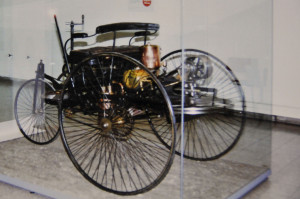Munich’s Deutsches Museum, on an island in the Isor River just beyond the medieval Isartor Gate, is the largest and finest museum of its kind in the world. The collection of more than 28,000 examples of human ingenuity from the Stone Age to the present includes one of the Wright Brothers’ first airplanes and the first roller skates, invented in Belgium. American visitors are often surprised by what is missing from the museum’s assemblage of firsts from around the world.
For example, the communications area houses the world’s first telephone, demonstrated by German Phillip Reis in 1862, fourteen years before Alexander Graham Bell summoned his assistant with “Watson come here.” The first successful telephonic message was the German equivalent of “the horse won’t eat cucumber salad.”
Protected behind glass in the transport section is the world’s first gasoline powered automobile, a three-wheeler built by German Karl Benz in 1885 and patented in Germany in 1886. The first American patent for a gasoline powered automobile was issued in 1895 to George Selden, a patent attorney who never actually built one.
A replica of the first programmable digital computer, called “Z3” and built in Germany by Konrad Zuse in 1941, is on display in the computer section. The first American programmable digital computer was at least three and maybe five years later.
A chronological exhibit shows the development of liquid fuel rockets, ending with the Saturn V rocket that took Americans to the moon. The first rocket in the series is the German V2, built during World War II to attack European cities. The first American-built rocket is a virtual copy of the V2. Also on display is the bench on which two German scientists first demonstrated nuclear fission in 1938.
A tour of the Deutsches Museum is like international travel generally. Visits to other countries provide plenty of opportunities to be proud of American accomplishments and to be glad to arrive home. Those visits also provide the sometimes humbling realization that the United States has not always been the first or the best, encouraging us to be thankful for the contributions and successes of others.
